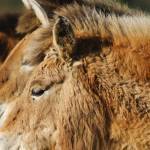Horse Has Too Much Hair? Think Cushing’s Disease

Most horses grow and shed hair in a seasonal pattern, producing a heavier coat in response to shorter hours of sunlight in the fall and losing this winter insulation as the days get longer in the spring.
By the time warm weather arrives, most horses have their slick and shiny summer hair. In some horses, however, this pattern gets off track. The hair follicles remain in their anagen, or growing, phase and never switch over to the telogen, or resting, phase. These horses grow a long, thick, wavy coat that fails to shed out with the return of warm weather.
This hypertrichosis—abnormal coat growth and retention—is seen in about 80% of horses with equine Cushing’s disease, a malady that plagues many senior equines. A recent study carried out in Australia found that in a group 325 horses over the age of 15, about 20% had equine Cushing’s disease. The researchers noted that while a quick glance at a horse might not reveal abnormal hair growth, the horse’s owner was likely to notice subtle early changes such as longer guard hairs, more hair on the backs of the horse’s legs or under the jaw, or a delay rather than an absence of shedding. These signs can signal the first stages of Cushing’s diseaseand should be followed up by a consultation with a veterinarian.
As with many health conditions, early diagnosis and treatment is important for management of equine Cushing’s disease. Pergolide, the medication used for treatment, can help hair follicles return to their normal cycle, eliminating the overheating and discomfort related to a thick coat that fails to shed.








